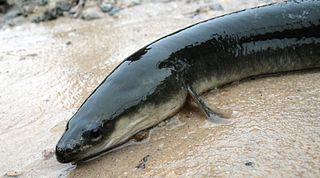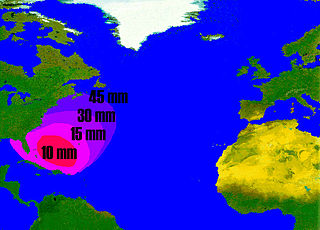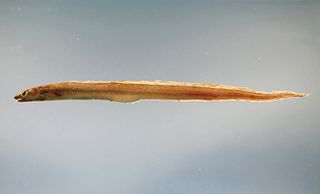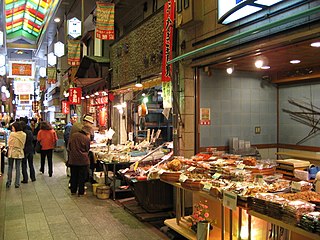
South Gloucestershire is a unitary authority area in the ceremonial county of Gloucestershire, South West England. Towns in the area include Yate, Chipping Sodbury, Thornbury, Filton, Patchway and Bradley Stoke, the latter three forming part of the northern Bristol suburbs. The unitary authority also covers many outlying villages and hamlets. The southern part of its area falls within the Greater Bristol urban area surrounding the city of Bristol.

The American eel is a facultative catadromous fish found on the eastern coast of North America. Freshwater eels are fish belonging to the elopomorph superorder, a group of phylogenetically ancient teleosts. The American eel has a slender, snake-like body that is covered with a mucus layer, which makes the eel appear to be naked and slimy despite the presence of minute scales. A long dorsal fin runs from the middle of the back and is continuous with a similar ventral fin. Pelvic fins are absent, and relatively small pectoral fins can be found near the midline, followed by the head and gill covers. Variations exist in coloration, from olive green, brown shading to greenish-yellow and light gray or white on the belly. Eels from clear water are often lighter than those from dark, tannic acid streams.

The eel is a long, thin bony fish of the order Anguilliformes. The species has a catadromous life cycle, that is: at different stages of development migrating between inland waterways and the deep ocean. Because fishermen never caught anything they recognized as young eels, the life cycle of the eel was a mystery for a very long period of scientific history.

The River Wye is the fourth-longest river in the UK, stretching some 250 kilometres from its source on Plynlimon in mid Wales to the Severn estuary. For much of its length the river forms part of the border between England and Wales. The Wye Valley is designated an Area of Outstanding Natural Beauty. The Wye is important for nature conservation and recreation, but is severely affected by pollution.

Frampton on Severn is a village and civil parish in Gloucestershire, England. The population is 1,432.

The Severn Estuary is the estuary of the River Severn, flowing into the Bristol Channel between South West England and South Wales. Its high tidal range, approximately 50 feet (15 m), means that it has been at the centre of discussions in the UK regarding renewable energy.

Fish balls are rounded meat balls made from fish paste which are then boiled or deep fried. Similar in composition to fishcake, fish balls are often made from fish mince or surimi, salt, and a culinary binder such as tapioca flour, corn, or potato starch.

The River Cam is a small river in Gloucestershire, England. It flows for 12 miles (20 km) north-westwards from the Cotswold Edge, across the Vale of Berkeley, into the Gloucester and Sharpness Canal.

Joey Chestnut is an American competitive eater. As of 2022, he is ranked first in the world by Major League Eating. He resides in Westfield, Indiana. Chestnut's height is 6 ft 0 in (1.83 m); his weight is 229 pounds (104 kg).

Patrick "Deep Dish" Bertoletti is an American competitive eater from Chicago.

The New Zealand longfin eel is a species of freshwater eel that is endemic to New Zealand. It is the largest freshwater eel in New Zealand and the only endemic species – the other eels found in New Zealand are the native shortfin eel, also found in Australia, and the naturally introduced Australian longfin eel. Longfin eels are long-lived, migrating to the Pacific Ocean near Tonga to breed at the end of their lives. They are good climbers as juveniles and so are found in streams and lakes a long way inland. An important traditional food source for Māori, longfin eels numbers are declining and they are classified as endangered, but over one hundred tonnes are still commercially fished each year.

The giant mottled eel, also known as the marbled eel, is a species of tropical anguillid eel that is found in the Indo-Pacific and adjacent freshwater habitats.

Lake Pillsbury is a lake in the Mendocino National Forest of Lake County, California, created from the Eel River and Hull Mountain watershed by Scott Dam. Elevation is 1,818 ft (554 m) with 65 mi (105 km) of shoreline and covering 2,003 acres (811 ha). Activities in the Lake Pillsbury Recreation Area include powerboating, fishing, swimming, sailing, picnicking, hiking and hang gliding. There are two main access roads to the lake. At the north end of the lake is a small gravel airstrip. About 400 vacation cabins including National Forest Recreational Residences ring the lake.

Eels are ray-finned fish belonging to the order Anguilliformes, which consists of eight suborders, 19 families, 111 genera, and about 800 species. Eels undergo considerable development from the early larval stage to the eventual adult stage and are usually predators.

The American conger is a species of eel in the family Congridae. Other common names for this fish include conger, dog eel, poison eel and sea eel. It is a marine fish with a widespread distribution in the Western Atlantic from Cape Cod in Massachusetts to northeastern Florida in United States and the northern Gulf of Mexico, and is also reported from near the mid-Atlantic island of St. Helena and off the coast of Nova Scotia in Canada. Dark grayish color, it can grow to about 6.5 feet (2.0 m) long and weigh more than 40 kg (88 lb).

Eels are elongated fish, ranging in length from five centimetres (2 in) to four metres (13 ft). Adults range in weight from 30 grams to over 25 kilograms. They possess no pelvic fins, and many species also lack pectoral fins. The dorsal and anal fins are fused with the caudal or tail fin, forming a single ribbon running along much of the length of the animal. Most eels live in the shallow waters of the ocean and burrow into sand, mud, or amongst rocks. A majority of eel species are nocturnal and thus are rarely seen. Sometimes, they are seen living together in holes, or "eel pits". Some species of eels live in deeper water on the continental shelves and over the slopes deep as 4,000 metres (13,000 ft). Only members of the family Anguillidae regularly inhabit fresh water, but they too return to the sea to breed.

Fish go through various life stages between fertilization and adulthood. The life of a fish start as spawned eggs which hatch into immotile larvae. These larval hatchlings are not yet capable of feeding themselves and carry a yolk sac which provides stored nutrition. Before the yolk sac completely disappears, the young fish must mature enough to be able to forage independently. When they have developed to the point where they are capable of feeding by themselves, the fish are called fry. When, in addition, they have developed scales and working fins, the transition to a juvenile fish is complete and it is called a fingerling, so called as they are typically about the size of human fingers. The juvenile stage lasts until the fish is fully grown, sexually mature and interacting with other adult fish.

Surimi is a paste made from fish or other meat. The term can also refer to a number of East Asian foods that use that paste as their primary ingredient. It is available in many shapes, forms, and textures, and is often used to mimic the texture and color of the meat of lobster, crab, grilled Japanese eel or shellfish.

Freshwater eel poaching and smuggling have emerged in recent years as a direct response to the sustained popularity of eels as food combined with the eels' low population, endangered status, and subsequent protections. Freshwater eel are elongated fish in the Anguillidae family of ray-finned fish. The three most commonly consumed eel species are the Japanese eel, European eel, and American eel.
Lamprey pie is a pastry dish made from sea lampreys or European river lampreys. Lampreys were a delicacy for the wealthy in medieval England and were often given as gifts to royalty as a means of seeking favour. It became tradition for the city of Gloucester to give the monarch a lamprey pie each Christmas. In 1200 the city was fined 40 marks for failing to provide the pie. The annual custom ended in 1836 but a pie is still presented on special occasions such as coronations and jubilees.




















